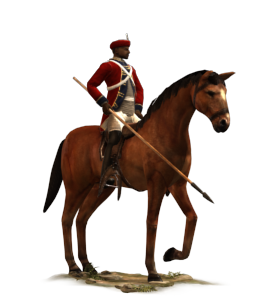Difference between revisions of "Native Indian Cavalry (ETW Unit)"
Tango12345 (talk | contribs) m (Quick-adding category "ETW Cavalry" (using HotCat)) |
Gen. Chris (talk | contribs) |
||
| Line 1: | Line 1: | ||
| − | {{Unit|image=[[Image:NI Cavalry.jpg]]|Class=Cavalry| | + | {{TW Unit|image=[[Image:NI Cavalry.jpg]] |
| + | |Class=Cavalry | ||
| + | |Unit Size=60 | ||
| + | |Weaponry=Lance | ||
| + | |Region=India | ||
| + | |Recruitment Cost=1020 | ||
| + | |Upkeep Cost=300 | ||
| + | |Building Requirements=Military Academy | ||
| + | |Tech Requirements=None | ||
| + | |Attributes=<li>Can hide in woodland</li> | ||
| + | <li>Resistant to heat fatigue</li> | ||
| + | <li>Diamond Formation</li> | ||
| + | <li>Wedge Formation</li> | ||
| + | }} | ||
==Overview== | ==Overview== | ||
| Line 6: | Line 19: | ||
The term ‘sipahi’ has its roots in ancient Persian where it means simply ‘army’. In common with cavalry formations the world over, sipahis have an air of high status and their elaborate arms, mounts and armor underline the fact that they are not mere foot-sloggers. A general who can call on their knows that once battle is joined, the shock of their charge, skilfully applied, can swiftly destroy all but the most resolute and disciplined enemy. | The term ‘sipahi’ has its roots in ancient Persian where it means simply ‘army’. In common with cavalry formations the world over, sipahis have an air of high status and their elaborate arms, mounts and armor underline the fact that they are not mere foot-sloggers. A general who can call on their knows that once battle is joined, the shock of their charge, skilfully applied, can swiftly destroy all but the most resolute and disciplined enemy. | ||
| + | |||
| + | == Details == | ||
| + | |||
| + | Native Indian Cavalry are cavalry that are excellent at charging headlong into masses of infantry, as their momentum behind their lance along with the sheer weight of their mount is a deadly combination to foot soldiers. However, once engaged lancers are at a disadvantage, meaning that a series of charges and retreats would be wise strategy for maximum damage on enemy units. | ||
==Faction== | ==Faction== | ||
Revision as of 22:39, 14 January 2013
Overview
Though prematurely abandoned by many European armies, the lance remains a formidable weapon when used at the charge, concentrating the weight of horse and rider into a single needle-sharp point. The lance has retained its popularity in India, a center of excellence with the weapon.
The term ‘sipahi’ has its roots in ancient Persian where it means simply ‘army’. In common with cavalry formations the world over, sipahis have an air of high status and their elaborate arms, mounts and armor underline the fact that they are not mere foot-sloggers. A general who can call on their knows that once battle is joined, the shock of their charge, skilfully applied, can swiftly destroy all but the most resolute and disciplined enemy.
Details
Native Indian Cavalry are cavalry that are excellent at charging headlong into masses of infantry, as their momentum behind their lance along with the sheer weight of their mount is a deadly combination to foot soldiers. However, once engaged lancers are at a disadvantage, meaning that a series of charges and retreats would be wise strategy for maximum damage on enemy units.
